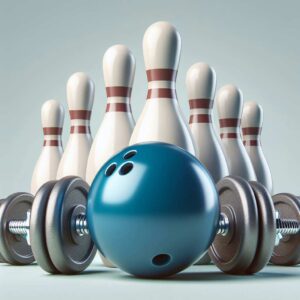Ten pin bowling is a beloved pastime enjoyed by people of all ages around the world. Whether you’re an experienced player or a complete beginner, the thrill of rolling a heavy ball down a long wooden lane and knocking down all ten pins is an experience like no other.
In this comprehensive guide, we’ll dive deep into the world of ten pin bowling, covering everything from the basic rules and scoring to the fundamental techniques and strategies that can help you improve your game.
Understanding the Basics of Ten Pin Bowling
The Ten Pin Bowling Lane
At the heart of the ten pin bowling experience is the bowling lane itself. A standard ten pin bowling lane measures 60 feet (18.29 meters) in length and 42 inches (106.68 cm) in width. The lane is made of highly polished wood or synthetic material, designed to provide a smooth and consistent surface for the bowling ball to roll on.
As you approach the foul line, you’ll notice the gutters on either side of the lane. These gutters are an essential part of the game, as they catch any balls that stray too far to the left or right, preventing them from knocking down the pins. Beyond the gutters, you’ll find the pin deck, the area where the ten pins are set up in a triangular formation, waiting to be toppled by your bowling ball.
The Bowling Ball
The bowling ball is the primary tool used in ten pin bowling, and choosing the right one can make a significant difference in your performance. Bowling balls come in a variety of weights, typically ranging from 6 pounds (2.72 kg) for children to 16 pounds (7.26 kg) for experienced adult players.
When selecting a bowling ball, it’s important to consider your strength, size, and skill level. A ball that’s too heavy can be difficult to control, while a ball that’s too light may not have the momentum to knock down all the pins. Many bowling alleys offer ball fittings, where a professional can help you find the perfect ball size and weight for your needs.
The Ten Pins
The ten pins are the ultimate targets in ten pin bowling, arranged in a triangular formation at the end of the lane. Each pin is approximately 15 inches (38.1 cm) tall and weighs between 3 and 3.5 pounds (1.36 to 1.59 kg). The pins are typically made of wood or a durable plastic material and are set up in a specific pattern, with the first pin, or “head pin,” positioned in the center of the formation.
Understanding the positioning and arrangement of the pins is crucial in developing your targeting and aiming strategies. By learning how the pins interact with each other and the overall impact of your ball’s trajectory, you can improve your chances of knocking down all ten pins, or achieving the coveted “strike.”
Ten Pin Bowling Rules and Scoring
The Frame and the Roll
In ten pin bowling, the game is divided into 10 frames, with each frame consisting of up to two rolls. The objective is to knock down all ten pins in as few rolls as possible.
On the first roll of a frame, if you knock down all ten pins, you’ve achieved a “strike.” If you don’t knock down all ten pins on the first roll, you have a second roll to try and knock down the remaining pins and achieve a “spare.” If you fail to knock down all the pins after the second roll, you’ve earned an “open frame,” and your score for that frame will be the sum of the pins you knocked down.
Calculating the Score
Scoring in ten pin bowling can be a bit complex, but with practice, it becomes easier to understand. Here’s a step-by-step guide to calculating the score:
- In a frame where you knock down all ten pins on the first roll (a strike), you receive 10 points, plus the total number of pins knocked down on the next two rolls.
- In a frame where you knock down all ten pins on the second roll (a spare), you receive 10 points, plus the number of pins knocked down on the next roll.
- In a frame where you don’t knock down all ten pins after the second roll (an open frame), your score is simply the total number of pins knocked down.
Bonus points are awarded for strikes and spares, which can significantly impact your overall score. By understanding the scoring system and keeping track of your progress, you can develop a better strategy and work towards improving your game.
Fundamental Techniques for Ten Pin Bowling
Proper Stance and Grip
Developing the right stance and grip is crucial for achieving a consistent and accurate bowling delivery. The proper stance involves standing with your feet shoulder-width apart, your weight evenly distributed, and your knees slightly bent. This position provides a stable foundation and allows you to generate power and control during your approach.
The grip is equally important, as it determines how you hold and release the bowling ball. The most common grip is the fingertip grip, where you insert your thumb and two or three fingers into the ball’s holes. This grip allows for a more controlled release and increased ball rotation, which can help you achieve better accuracy and hook shots.
The Approach and Release
The approach and release are the two most important components of your bowling delivery. The approach involves a series of steps leading up to the foul line, where you’ll release the ball. The key is to maintain a smooth, consistent approach, with your steps timed to your ball’s release.
As you reach the foul line, it’s crucial to execute a clean and controlled release. This involves keeping your arm and wrist aligned, releasing the ball at the appropriate time, and following through with your swing. By mastering the approach and release, you’ll be able to generate more power, control the ball’s trajectory, and consistently knock down more pins.
Aiming and Targeting
Aiming and targeting are essential skills in ten pin bowling, as they determine the ball’s path and the pins it will hit. The most common aiming strategy is to focus on the “pocket,” the area between the 1 pin (the headpin) and the 3 pin (the pin to the right of the headpin). By hitting the pocket, you increase your chances of knocking down all ten pins or achieving a strike.
However, the ball’s trajectory and the pin configuration can also be affected by factors such as lane conditions, ball speed, and spin. By learning to read the lane and adjusting your aim accordingly, you can develop a more versatile and effective targeting strategy.
Tips and Strategies for Improving Your Ten Pin Bowling
Developing Consistency
Consistency is the key to success in ten pin bowling. The more you practice and hone your technique, the more consistent your ball delivery and results will become. Consistent practice helps build muscle memory, allowing you to execute your approach, release, and targeting with precision.
In addition to regular practice, it’s important to monitor your technique and make adjustments as needed. Pay attention to your stance, grip, and release, and be willing to experiment with small changes to find what works best for you. By developing a consistent and reliable technique, you’ll be able to achieve more strikes, spares, and higher overall scores.
Analyzing and Adapting
Ten pin bowling is a dynamic sport, with the lane conditions, ball selection, and player strategies all playing a crucial role in the game’s outcome. As you progress in your bowling journey, it’s important to learn how to analyze the lane conditions and adjust your approach accordingly.
Factors such as oil patterns, humidity, and temperature can affect the ball’s trajectory and the pin’s behavior. By understanding how these elements impact your game, you can make informed decisions about ball selection, ball speed, and targeting adjustments. Constantly monitoring and adapting to the changing lane conditions will help you become a more versatile and effective ten pin bowler.
Bowler’s Etiquette and Sportsmanship
Ten pin bowling is not only a competitive sport but also a social activity. Maintaining a positive and supportive attitude on the lanes is essential for both personal enjoyment and the overall bowling experience.
Respect the rules of the game, be courteous to your fellow bowlers, and offer encouragement and congratulations when appropriate. Avoid disruptive behaviors, such as excessive noise or interfering with other players’ turns.
By demonstrating good sportsmanship and etiquette, you’ll not only improve your own experience but also contribute to a welcoming and inclusive bowling environment for everyone.
Conclusion
Ten pin bowling is a sport that offers a unique blend of physical skill, strategic thinking, and social interaction. Whether you’re a seasoned player or a complete beginner, mastering the fundamentals and developing consistent techniques can help you improve your game and enjoy the sport to the fullest.
Remember to practice regularly, analyze and adapt to the changing lane conditions, and always maintain a positive and sportsmanlike attitude. With dedication and a willingness to learn, you can become a skilled ten pin bowler and experience the thrill of knocking down all ten pins, one roll at a time.
So, grab your bowling ball, lace up your shoes, and get ready to hit the lanes. The world of ten pin bowling is waiting for you to explore, discover, and conquer!





